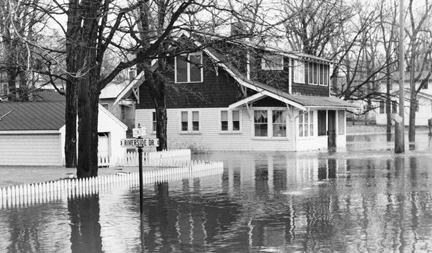Waterloo flood of 1961 recalled, 60 years later
Posted
by Pat Kinney
on Monday, May 10, 2021
This year's dry spring is nothing to complain about. Not compared to the alternative.
Anyone who was around here 60 years ago this spring -- and many springs and summers since -- knows that.
For those who weren't there's a reminder outside Waterloo City Hall -- a marker in tribute to those who fought the then-record flood in the spring of 1961.
According to a report by the U.S. Geological Survey, a combination, of heavy snow, an unusually wet March and rapidly rising temperatures all combined to make a perfect storm, so to speak, of disaster for Waterloo and other locations in the upper Midwest.
"Flood damage was high," the USGS reported. "Approximately 40 percent of Charles City, Iowa, was inundated by waters from Cedar River, and at least a hundred families evacuated their homes. Five hundred houses were flooded in Waterloo and 5,000 persons were evacuated at Cedar Rapids.

1961 flood-Riverside and Conger. Courier Photo
Damage at Waterloo was estimated at $60 million." United Press International reported some 3,000 Waterloo residents had to be evacuated from their homes. Water could be seen splashing against the sides and over the decks of several downtown bridge which existed at that time.
It could have been worse, but wasn't, thanks to community volunteers. Young people, many of them high school students, filled sandbags and worked to the point of exhaustion fighting floodwaters. The marker which stands outside City Hall is in tribute to them.
The National Weather Service reported the Cedar River crested in downtown Waterloo at 21.86 feet on March 29, 1961, almost nine feet above flood stage. It was a record that stood until the flood of 2008, when the Cedar crested at 25.39 feet in Waterloo, with a secondary crest of 21.9 feet.
.jpg)
1961 flood Riverside Drive. Grout Photo
The volunteer effort that saved the city in 1961 has been repeated in Waterloo and Cedar Falls many years since -- through the 1960s and '70s, the floods of 1993 and 1999, and, most recently, the floods of 2008 and 2016. The communities have made significant flood control improvements over the years, from the 1961 flood through the most recent major one in 2016. But when the waters are high and the chips are down, it still takes ordinary people doing extraordinary things to protect our communities and help them recover once the crisis has passed.
